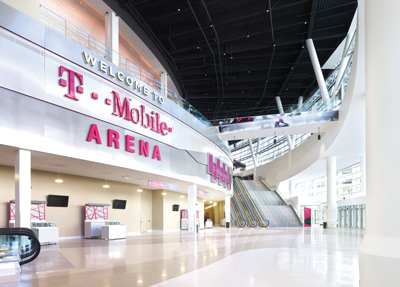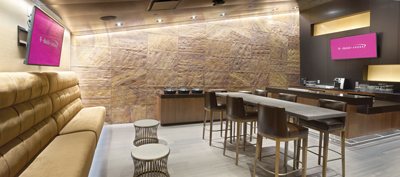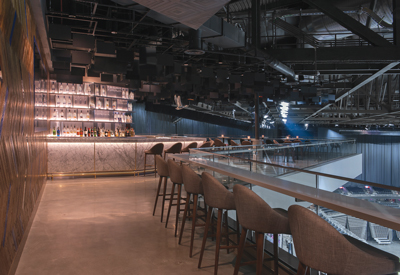Looking up at the 210-foot-wide video wall that dominates the vast plaza outside T-Mobile Arena on the Las Vegas Strip, the executive who shepherded the project flashed back to a scouting trip to Miami, and his first look at the LED screen attached to AmericanAirlines Arena’s exterior wall.
“We thought: It’s beautiful. Love it. Let’s supersize it,” said Rick Arpin, senior vice president of entertainment for MGM Resorts International, which developed the arena as an equal partner with AEG. “The plaza here is like L.A. Live. But that’s an acre. Let’s make it two acres. Let’s make it all bigger because Vegas often has bigger events.”
The giant video wall, among the industry’s bigger boards attached to an arena’s outer walls, defines the $375 million arena, which opened with a concert headlined by The Killers in April and a month later held its first sporting event, Canelo Alvarez’s knockout of Amir Khan on Cinco de Mayo weekend.
So too do a pair of tower clubs — branded as the Grey Goose Nest and Stella Artois Loft — which hang out over the lower bowl from 96 feet up.
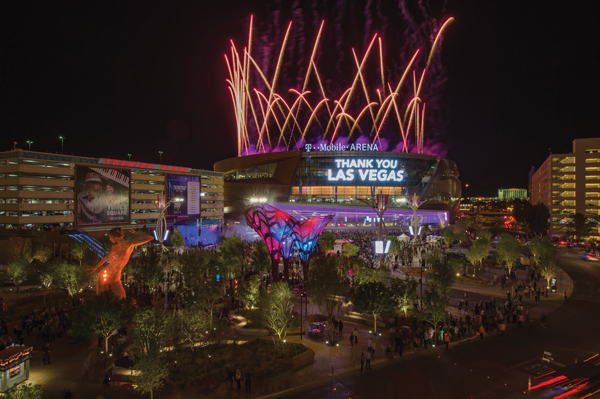 |
Fireworks crowned the arena during the grand opening celebration in April.
Photo by: AL POWERS
|
Additionally, T-Mobile Arena showcases the next generation of Hyde Lounge, a popular nightclub concept tied to retrofits at Staples Center and AmericanAirlines Arena, and which, for the first time, gets its own purpose-built space in Vegas.
The arena’s suites feature sofa-style banquette seating, compared with the traditional setup with fixed seats in the bowl. The twist on premium hospitality fits the Vegas style, allowing guests to sit close or stretch out along those mini-couches.
Inside T-Mobile Arena
■ City: Las Vegas
■ Owner/developer: AEG and MGM Resorts International
■ Project cost: $375 million
■ Architect: Populous
■ General contractor: Hunt-Penta Joint Venture
■ Owner’s representative: Icon
Venue Group
■ Operator: MGM
■ Concessionaire: Levy Restaurants
■ Square footage: 650,000
■ Suites: 44
■ Bunker suites: 8
■ Party suites: 2
■ Loge boxes: 42
■ Seating capacity: Boxing/UFC: 20,000; hockey: 17,500; basketball: 18,000
■ Sustainability: LEED Gold
■ Naming rights: T-Mobile
■ Founding partners: Optum, Anheuser-Busch, Toshiba, Schneider Electric, Bank of America, Black Clover, Coca-Cola, Cox
■ Branded spaces: Toshiba Plaza, Grey Goose Nest, Stella Artois Loft
Sources: Populous, SportsBusiness Journal research
But what sets T-Mobile Arena apart most is its address.
There is no place like Vegas, a city of 600,000 that last year attracted 42 million visitors from around the world. Its renowned four-mile, resort-lined entertainment strip contains replicas of the Eiffel Tower, the New York skyline, the Colosseum of Rome, the canals of Venice and the pyramids of Egypt.
“We had to ‘out-Vegas’ Vegas in some ways,” said Brad Clark, design principal for Populous, the arena’s architect. “From a conceptual standpoint, we were trying to do an authentic building in Vegas, which is not what you always see out there. There are lots of re-creations of other places.”
Populous also had to design the arena to meet standards for NBA and NHL teams with regard to locker rooms and support spaces. Clark knew the drill based on his experience designing two NHL-ready arenas without sports tenants: Videotron Centre in Quebec City and Sprint Center in Kansas City. In Vegas, where an investment group led by billionaire businessman Bill Foley is pursuing an NHL expansion team, the architect was tasked with finding the right balance between meeting the needs of a potential hockey team and producing revenue tied to boxing, the UFC, concerts and other special events.
MGM’s older arena, the Grand Garden, seats 16,800 but has no suites, a common feature in new buildings when it opened in 1993. For a resort built around gaming, a concert or big fight was a great way to attract visitors. But the idea was to get them to spend their time and money at the blackjack table, not at a concert.
The model has shifted since those days. When the Grand Garden opened, gambling accounted for 57 percent of revenue on the Vegas Strip, according to Nevada Gaming Control Board filings. Last year, it was 35 percent of revenue. While gambling has declined, sales at restaurants, nightclubs, pool complexes and shops has soared.
The Strip is increasingly about guests spending money, rather than losing it.
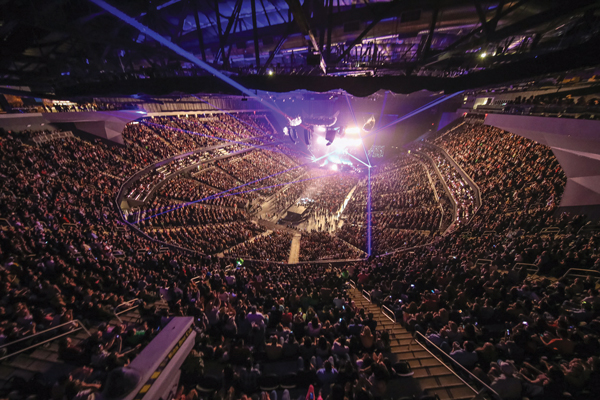 |
The building expects to play host to plenty of boxing (Alvarez-Khan from earlier this month, below) and concerts (The Killers played for the arena’s grand opening, above).
Photo by: TONY TRAN PHOTOGRAPHY
|
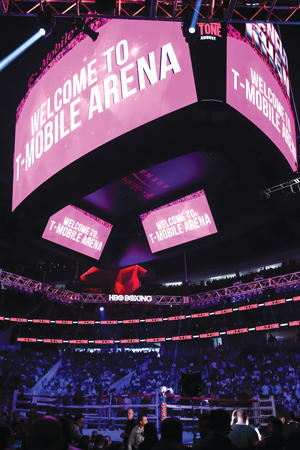 |
Photo by: MGM RESORTS
|
A noteworthy example can be seen in the vast plaza at the arena’s front doors, which can accommodate three stages and about 10,000 people. In the heydays of the Grand Garden and the nearby Mandalay Bay Events Center, it would have been unheard of to funnel tourists onto the streets, rather than through the indoor maze of casinos and shops that connect many of the properties.
On a Monday afternoon a few hours before the tipoff of the NCAA men’s basketball final, two days before the arena opened, Arpin painted a picture unlike any Vegas had seen.
“Let’s do a festival, or a food and wine thing, or viewing parties,” Arpin said. “If we were open tonight, we could put the game up there. Have some food trucks and have some fun with it.”
The exterior design also is a fit for today’s Vegas. The rusty-looking steel skin, designed in a wavy motion circling the building, is themed after the desert region’s sand dunes. The sloping curves along the outer skin are functional as well, forming shaded outdoor balconies stacked on both public and premium levels. Those balconies can be converted to stages for boxing and UFC weigh-ins as well as for bands performing for crowds gathered below on the Toshiba Plaza outside the arena.
One of the more daunting questions for MGM and AEG was the manner in which the Vegas market would respond to premium seating, and especially suites.
Though Vegas long has been an entertainment mecca, the arenas tied to casinos on the Strip were bare bones. So there was no precedent to definitively determine the suite market. AEG worked to calibrate both the number of suites and the prices. In Vegas, that meant starting with the resort properties — most notably 50 percent equity owner MGM.
MGM and AEG settled on pricing the 42 regular suites at $165,000 to $200,000 a year, tied to five-, seven- and 10-year terms. Club seats carry a $3,500 annual fee plus the cost of event tickets.
On its own, MGM Resorts International bought $7 million in premium seat inventory to entertain its clients, according to Mark Prows, MGM’s vice president of arenas (SportsBusiness Journal, July 21-27, 2014).
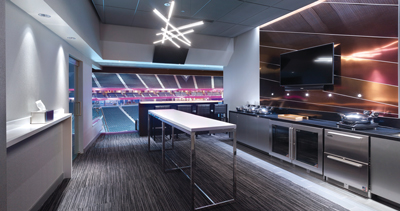 |
Photos by: MGM RESORTS
|
“Frankly, we could have priced a little higher on the suite product,” Arpin said. “We’re sold out and have a waiting list going. But we were wondering who would buy these things.
“We were huddling with our marketing folks to say, ‘What do you think you’re going to need? Remember, they’re not used to having the premium product either.
So we spent a lot of time on that.”
Initial designs called for two suite levels, but with no NHL team, MGM and AEG opted to scale back to a single level of 42, with two more that would be behind the stage at concerts that could be offered individually for other events. They also built two party suites behind the stage and eight high-end bunker suites at event level.
The small number of suites falls in line with the industry trend of designing fewer suites in big-league buildings. NBA arena developments in Sacramento and Milwaukee have fewer than 40 suites with greater inventory distributed among club seat and loge box products.
“It’s a tough call,” Clark said. “We’ve seen a lot of venues turn suites into other premium options. In Vegas, they get a lot of customers from other markets. It will certainly support the total number we’ve got in the arena, but at the same time, some of the population is more transient.”
MGM committed to lease eight of the 42 suites and two bunker suites, then took the rest to the other gaming companies, who made their choices at the same price. Because the partners weren’t certain that the midsize and small companies in the market could afford the prices set for the casino operators, the contracts signed initially included “most favored nation” clauses, which would reset the terms if it took a lower price to get the next wave of buyers into the building.
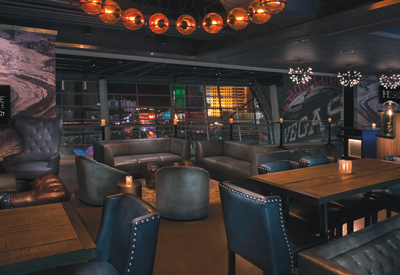 |
Touring the premium spaces: Hyde Lounge (above), with a view of the Strip; an event level suite (below); and the Grey Goose Nest, one of the arena’s two tower clubs.
Photos by: MGM RESORTS
|
“For $200,000, the casino is good, because they know one boxing match can make their entire year,” Arpin said. “But what is a midsized business in Las Vegas going to want? Turns out, we were fine. Those MFNs never had to kick in. We all paid the price and we’re good.”
While the arena is without a pro sports tenant, it is not without sports programming. Along with boxing and UFC dates — including UFC 200 set for July 9 — the arena has a three-year deal to host the Pac-12 men’s basketball tournament, held at the MGM
Grand Garden the last three years. It also has the Pro Bull Riders world finals, which will move from the Thomas & Mack Center.
“People may not know what the event is, but I know in May and September there will be big boxing matches,” Arpin said. “I know I’ll
have a few UFC fights every year. I know there will be concerts. I don’t know who it’ll be, but I know I’ll want to be there. So now I own the real estate. It’s a testament to the market for people to want to be in at prices that, quite frankly, are pretty similar to other markets that have a tenant.”
MGM and AEG hope that a continued strong showing hosting the Pac-12 tournament might swing the NCAA’s long-standing aversion toward awarding regional and national events to a state that allows sports wagering. Facing a dearth of sites in the Western region, the NCAA basketball tournament typically alternates its regional final sites among Los Angeles, Anaheim, San Jose and Phoenix.
“NCAA championships can be huge for this city,” Arpin said. “You’ve got to be allowed [by the NCAA] to do it. But it’s a huge market for us. You’ve got all the infrastructure here. This city should be able to win bids. We see that as a great opportunity.”






